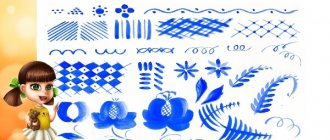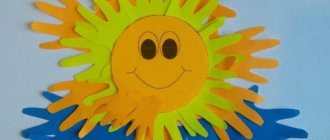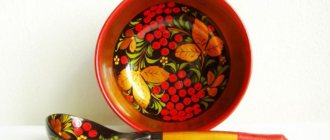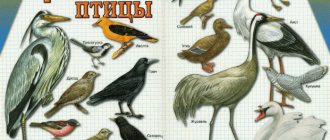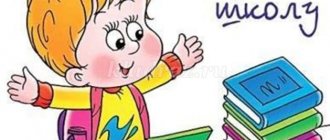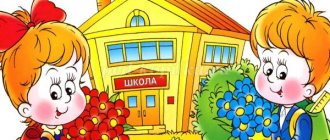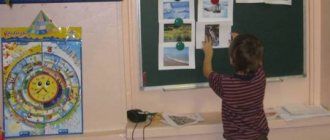Program content:
— to cultivate in children a love for Russian applied art, to expand and enrich children’s knowledge;
- create a desire to master drawing skills based on Khokhloma painting;
- teach to see beauty and originality in the products of Khokhloma masters, develop artistic taste;
- introduce the element “grass”, pay attention to the smoothness of the lines, consolidate the technical techniques in drawing this element.
Material: screen, finished products of Khokhloma masters: cups, spoons, illustrations, pointer, strips of white paper, brushes, green gouache.
Preliminary work: examining the products of Khokhloma masters, illustrations, making an album together with the children.
Progress of the lesson
Teacher (reads a poem).
Khokhloma painting - a scattering of scarlet berries,
Echoes of summer in the green grass.
Groves, copses, silk splashes
Sunny honey golden foliage. Guys, you already guessed that this beautiful poem was written about the products that you see on my table. And they were painted by wonderful craftsmen. This painting is called Khokhloma.
This painting originated a long time ago. It got its name from the name of the village of Khokhloma, where they began to decorate wooden products. Then, in other quiet Volga villages, lost in the wilderness of endless forests, they began to paint wooden accessories of peasant life. All these items (display) are made of wood and then painted. Please note that the design appears to be gold, but no gold is used in the preparation of these items. Wooden products were covered with liquid clay - “wapa”, soaked in raw linseed oil, puttied, and covered with drying oil. When it dried, the products were covered with a layer of aluminum powder. Then they were painted, dried, rubbed with drying oil, varnished twice and hardened in an oven. The varnish darkened and gave the product a golden hue. You see how many times the master picked up the same thing, how long and how lovingly he worked.
Let's look at what's on my desk. Pay attention to the elements of the painting. What do you see?
Children can easily recognize berries, flowers, and leaves.
Educator. What colors do the masters use?
Children. Red, green, yellow, black.
Educator. The masters apply the drawings with a precise, confident movement with a flexible brush, making a smooth bend of the branch, as if bending under the weight of a ripe berry, the graceful “tendrils” of thin grasses are about to sway in a light wind. Khokhloma masters know many wonderful painting techniques - here there are large golden flowers on a red background, and ancient “grass” painting - thin, thin black and red grass curls merrily across a golden background.
These things serve as a wonderful decoration for any room, and at the same time they are necessary and useful in everyday life. The room becomes brighter and more comfortable from the warm golden shine of Khokhloma products.
Today we will get acquainted with one of the main elements - “weed”. See how to draw it correctly. We take a little green paint onto the tip of the brush and draw a line from top to bottom, but it is not straight, but slightly curved, as if swaying in the wind. We draw the line smoothly, without lifting the brush from the paper.
Children are asked to repeat how to draw “grass.” Individual work is carried out during the lesson.
Analysis. Three guys choose works where the grass is drawn smoothly, neatly, and the line is thin. Why did you choose this job? How are the lines drawn? What's positive about it? What is the quality of work?
Self-analysis using color signal circles.
Master class “Khokhloma painting on a cutting board “Gift for Mom”
Municipal budgetary institution of additional education
CENTER FOR CREATIVITY DEVELOPMENT OF CHILDREN AND YOUTH
municipal formation Slavyansky district
Master Class
“Khokhloma painting on a cutting board “Gift for Mom”
Compiled by:
Kuznetsova Evelina Viktorovna
MBU DO TsRTDIYu MO Slavyansky district
Additional education teacher
Slavyansky district
2021
The spring awakening of nature, the riot of summer colors, the generosity of Russian autumn with crimson and gold leaves burning in the sun feeds the folk art of Khokhloma with eternally living juices.
Khokhloma, which has long-standing artistic, craft and technological traditions, has now become one of the most vibrant and popular crafts of modern folk art.
I am the head of the children’s association “Art Painting,” and my students really like to paint various objects: spoons, bowls, boards, plates, displays, panels, trays, etc.
I would like to present to your attention a master class on Khokhloma painting on a cutting board.
Materials and tools
Gouache, brushes, pencil, eraser, cotton swabs, toothpicks or matches, clear varnish
Cutting board (you can use a ready-made board purchased in a store, or you can cut it out of a piece of plywood using a jigsaw), sandpaper.
Step-by-step instructions for performing the work:
Step 1: Sand the board until perfectly smooth
Step 2: We start painting with the idea of a composition (pattern) in the “GRASS” style.
Its basis is floral ornament. The artist applies thin leading line strokes in black to the surface of the product (column or squirrel brush No. 1).
Step 3: Apply rich green strokes to the surface of the product, similar to elongated leaves.
Step 4: Using a cotton swab (poke), apply bunches of viburnum berries with red gouache.
Step 5: Lifting the leaves, i.e. drawing the veins of the leaf with black paint using a thin brush from the edge of the leaf to its center (herringbone).
Step 6: Using a cotton swab wrapped around a toothpick, we place pokes (eyes) on the berries with black paint and draw an outline on each leaf, on one side only.
Step 7: Filling the voids with additional plant elements - flowers (large pokes in the shape of a 3- or 5-petal flower are applied with orange paint. Small pokes in black are placed in the center of the flowers.
Step 8: The final stage of painting is the grass (eyelashes, antennae, blades of grass, pressure), made in black along the entire leading line.
The edges of the flowers are bordered with curls. Small red pokes are placed on the grass.
Methodological manual for educators “Khokhloma painting”
Khokhloma painting
The village of Khokhloma, where fairs selling wooden utensils and painted spoons were held, gave its name to a whole craft that is now well known in our country and abroad. The artistic style of Khokhloma painting, according to folk art researchers, is associated with ancient Russian decorative art. And the Nizhny Novgorod region serves as confirmation of this. Since ancient times, artistic crafts have flourished here - icon painting, design of handwritten books, carving and painting on wood (gingerbread, heated boards, dishes), sewing with gold and silk threads on velvet, silk and much more. Developing alongside these types of folk art, Khokhloma painting was influenced by them, but its own features developed brightly and individually.
Having received its name from the village of Khokhloma, where wooden products with paintings made on a lathe were brought for sale, Khokhloma painting began to develop in Rus'.
By the end of the 19th century, Khokhloma furniture and dishes appeared at major foreign and domestic exhibitions in Paris, London, Chicago, Berlin, Cairo, and Beirut.
The art of Khokhloma painting becomes unique thanks to the use of a special technique for finishing products to obtain a luminous golden background without the use of precious metal. An item turned on a lathe or cut with a knife from linden or birch is carefully covered with a thin layer of clay. The dried item, repeatedly coated with drying oil, is painted with silver aluminum powder, which is then painted with oil paints, mainly black and red as the most heat-resistant. The painted item is again dried several times and dried in an oven, after which the silver gives a golden hue, and the red patterns glow even more on a gold and black background, which is why Khokhloma is called “golden” and “fiery”.
Khokhloma painting is a floral ornament composed of a small number of motifs called “grass”, “apple”, “berry”, “grapes”, “leaf”, “shaft”, “curl”.
Khokhloma painting is characterized by two types of writing: top painting and background painting. The leading painting is the herbal letter.
The grass is based on a smoothly bending stem, from which curved stems extend in all directions. Along their entire length, they are densely dotted with large and small curls, reminiscent of narrow leaves, each of which has its own special shape. Some leaves are grouped around small stems, others densely cover the stem, interspersed with thin short strokes. The movement of all stems and leaves is subordinated to the smooth movement of the stem. We can note two frequently occurring compositional types of “grass”. One, decorating the inner surface of a bowl or dish, is characterized by the uniform movement of a wavy stem around the center of the bottom with adjacent smoothly curved side stems, leaves and berries, densely filling the entire surface of the thing. The other, decorating the outer surface of the stand or salt shaker, is distinguished by the longitudinal movement of the wavy stem of the branch, widely covering the object form.
